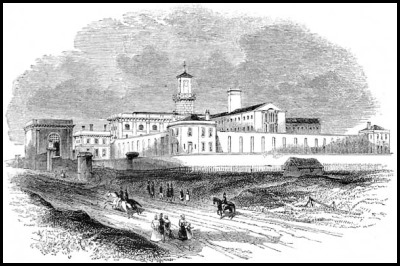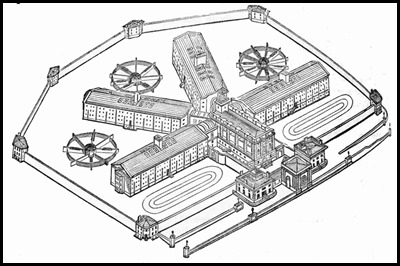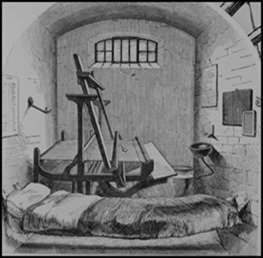PA Separate Prison

|
Port Arthur Separate Prison
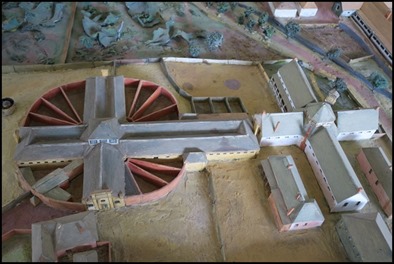 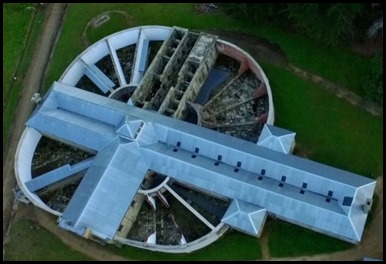 Model of the Separate
Prison (chapel seen at six o’clock position) – Visitor’s Centre, Port
Arthur. The Separate Prison (today). When built it
was a bold experiment in changing men’s behaviour by working on their mind
rather than their body. Inspired by Quaker ideas, it was intended to benefit the
inmate. Ultimately it was just another form of cruelty. Many of the inmates were
there to be punished for crimes like absconding, assault, sexual offences,
insubordination, insolence and misconduct. Others were sent there on arrival to
serve a portion of their sentence.
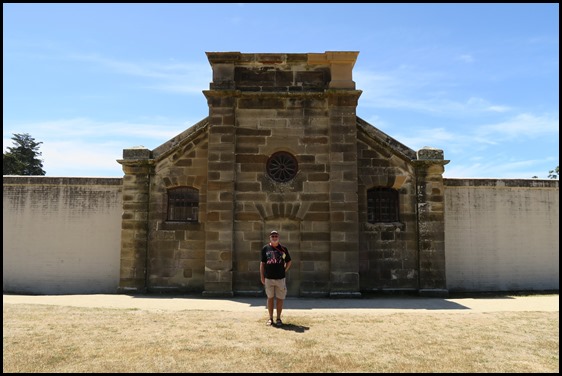 Bear outside the
chapel.
Fifty cells arranged in three
corridors with a central hall, on one side of which is a chapel.... Each cell is
furnished with a hammock, table, stool, and cupboard precisely similar to those
in use in Pentonville Prison..... Dr John S. Hampton.
1852.
By the early 1840’s a major change in the
management of British prisons, with a move away from physical punishment.
Pentonville Prison in London became the model for a number of colonial prisons.
The new style of prison comprised separate cells where prisoners could be
confined night and day but allowed some degree of exercise and employment.
This prison opened in 1849. Prisoners were
kept strictly apart from each other and not a word was heard except at chapel.
In the 1850’s it was used for the worst class of criminal in an effort to bring
their minds ‘to a more healthy condition’. Later, the prison was used for long
term prisoners as well as those who had committed serious offences or who had
absconded.
After the closure of Port Arthur the
prison was purchased in 1884 for conversion to a hotel. The chapel had been
converted to a billiard room and other building had begun. However the 1895
bushfire gutted the building and the Government resumed ownership in
1916.
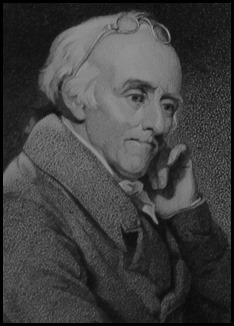 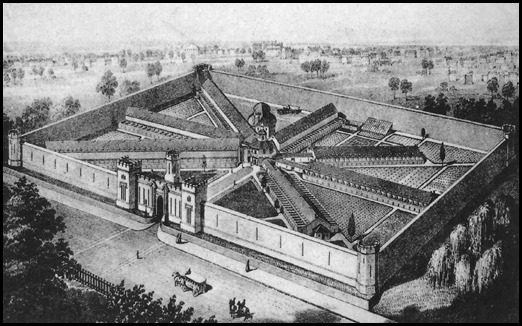 American Prison reformer Benjamin Rush (1746-1813) – Mary Evans Picture Library.
ESP.
How
it all began. In 1784 Benjamin Rush wrote to William Peterkin:- Europe resembles an old garment that has been turned.
The habits of your people forbid every species of improvement in human
happiness. In America, everything is new and yielding. Here, genius and
benevolence may have full scope. Here the benefactor of mankind may realize all
his schemes.
The Pennsylvania System: Benjamin Rush and a group of Quaker reformers formed the Philadelphia Society for Alleviating the Miseries of Public Prisons in 1787. The Society campaigned to build prisons where solitary confinement replaced physical punishment. In isolation from others, prisoners would be forced to look inwards and repent their crimes. Designed by John Haviland and opened on the 25th of October 1829, Eastern State is considered to be the world's first true penitentiary. Eastern State's revolutionary system of incarceration, dubbed the "Pennsylvania system" or separate system, encouraged separate confinement (the warden was legally required to visit every inmate every day, and the overseers were mandated to see each inmate three times a day) as a form of rehabilitation. For want of room to separate them, the young associate with the old offenders, the petty thief becomes the pupil of the highway robber......and from the experience of age derives instruction which fits him to be a pest and terror to society. A community of interests and design is excited among them, and instead of reformation, ruin is the general result. – Committee, Report on the Penitentiary System. The Society’s ideal was realised when the Eastern State Penitentiary (known as ESP) opened in 1829. It was the largest and most expensive public building in America. While the President’s residence had no running water or central heating, these inmates had both. Tourists flocked to see this architectural wonder, designed like a church with its nine metre high barrel vaulted hallways and tall arched windows. Eastern State Penitentiary was designed to intimidate the public as well as the new inmates who crossed its threshold. The design and execution import a grave, severe and
awful character....The effect which it produces on the imagination is peculiarly
impressive, solemn and instructive..... – George Smith, A View and Description of the Eastern
Penitentiary of Pennsylvania 1830.
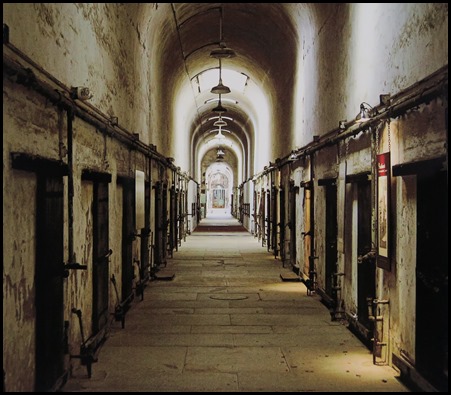 The quest for complete separation was taken to new extremes in
ESP. Each man was kept in solitary confinement in his
cell for twenty three hours each day; he wore a mask when outside his cell to
prevent communication; he was only allowed to read the Bible; he exercised in an
individual yard attached to his cell; he was fed through a hatch in his cell
door. The only sound was the word of God from the preacher in the corridor. Each
cell had its own skylight, called the ‘Eye of God’. so that the prisoner could
reflect on the light of God and learn to acknowledge His omnipotence. Once
the prisoner has experienced the operation of this Institution on a broken
spirit and contrite heart, he learns, and he feels, that moral and religious
reflection, relieved by industrious occupations of his trade..... divest his
solitary cell of all its horrors, and its punishment of much of its severity.
Board of Directors, First and Second Annual Report
1831.
Men sleep more, dream more, have stronger cravings for
food, and time past seems to them shorter, and time to come longer, in Prison,
than when at Liberty...... Some in Prison can hardly be prevailed upon to kill,
or even to frighten, the rats or mice that come into their cells. They are
pleased with their company, love to look on their bright eyes, and see them jump
about the cell.... Some pass their lonely hours in singing to themselves without
audible sound... Others often employ their thoughts, when alone, in framing
speeches on different subjects... Gerrish Bennett, Chaplain, Pittsburgh
Prison 1836.
A rival system, called the ‘silent system’, was developed at
Auburn Prison in New York State. Here men worked in a large communal area with a
strict rule of silence. Prison reformers throughout the world debated the merits
of each system while the Pennsylvania System was favoured in
Europe.
Can there be a combination more powerful for reformation
than that of a prison which hands over the prisoner to all the trials of
solitude, leads him through reflection to remorse, through religion to hope;
makes him industrious by the burden of idleness, and which, whilst it inflicts
the torment of solitude, makes him find a charm in the converse of pious men,
whom otherwise he would have seen with indifference? - Gustav de Beaumont
& Alexis de Tocqueville – On the Penitentiary System in United States,
1833.
Inside, ESP was a new machine-like instrument to isolate and
control body and mind. The English reformer Jeremy Bentham’s Panopticon
inspired its central surveillance point and radiating wings. There was a
practical emphasis on thick walls and specially designed plumbing to ensure
silence and complete separation between prisoners.
By the distribution of the several blocks of Cells forming
so many radiating lines to the Observatory or Watch-house....a watchman can,
from one point, command a view of the extremity of the passages of the cells, or
traverse under cover unobserved by the prisoners and overlook every cell; when
they are exercising in their yards, the same watchman.... can see into every
yard. John Haviland, A Description of Haviland’s Design for the New
Penitentiary, Now Erecting near Philadelphia
1824.
English reformers also favoured the Pennsylvania System over
the silent system followed in Auburn Prison, New York. It became the model for
Pentonville Prison, built in London in 1842. And Port Arthur’s Separate Prison
was based on the Pentonville model.
In judging of the comparative merits of the two systems it
will be seen that the discipline of Auburn is of a physical, that of
Philadelphia of a moral character. The whip inflicts immediate pain, but
solitude inspires permanent terror. The former degrades while it humiliates; the
latter subdues but it does not debase. At Auburn the convict is uniformly
treated with harshness, at Philadelphia with civility; the one contributes to
harden, the other to soften the affectations. Auburn stimulates vindictive
feelings; Philadelphia induces habitual submission........... Solitary
imprisonment is not only an exemplary punishment but a powerful agent in the
reformation of morals. In the silence of the cell contamination cannot be
received or imparted. – William Crawford, Report on the
Penitentiaries of the United States 1835.
But even before Port Arthur’s Separate Prison was built, there
was serious concerns about the effect that the Separate System had upon inmates.
After he had visited American prisons in 1842 Charles Dickens became one of the
most outspoken critics of the Pennsylvania System.
On the haggard face of every man among these prisoners,
the same _expression_ sat. I know not what to liken it to. It had something of
that strained attention which we see upon the faces of the blind and deaf,
mingled with a kind of horror, as though they had all been secretly terrified.
Charles Dickens, American Notes 1842.
The ornate facade of Pentonville Prison had a new machine-like system. In 1834 the Home Office had sent Sir William Crawford, a member of the Society for the Improvement of Prison Discipline, to inspect American prisons. Crawford was impressed with the Eastern State Penitentiary in Pennsylvania. Pentonville, also known as Model Prison, was designed with the same central inspection block and radiating cell wings as Eastern State Penitentiary. It was to be a machine to subdue the spirit of men. The regime was based on silence, isolation, work and religious instruction. It became one of the most copied prisons in the world; within six years fifty four prisons with eleven thousand cells had followed its design – including the Separate Prison at Port Arthur.
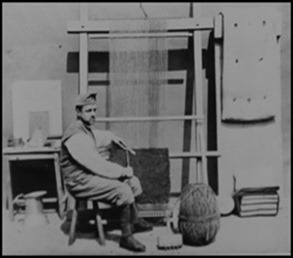  From the
central corridor within radiate four wings and one long entrance hall leads to a
central point. The interior of each of the four wings or ‘corridors’ is fitted
with one hundred and thirty cells, arranged in three storeys, one above the
other, and each floor contains some forty-odd apartments for separate
confinement – Henry Mayhew & John Binny, The Criminal Prisons of
London, 1861.
Almost as soon as Pentonville opened Medical Officers and
Chaplains observed that solitary confinement had a marked psychological impact
on prisoners.
Convict DF 4920: Five and a half months after
admission, he was observed to be depressed in spirit and strange in his manner
and conversation. He seemed to be oppressed by vague fears and apprehensions of
impending evil which increased towards night. He stated that he was in constant
dread of punishment for breaking the prison rules... Pentonville Prison
Commissioners Report 1854.
As time went on there was growing concern at what seemed to be
an unusually high number of cases of ‘insanity’ among the prisoners. These rates
were many times higher than those found in prisons run along different
lines.
Prisoners came to him complaining of delusions. One of
them said “there was something the matter with his head, and something was
eating away at his nose”. Another gad “various fancies that insects had got
inside his head, that he has seen his mother, and raves about his father’s
spirit which he said was inside..... another became obsessed that a small bird
was a sign portending the death of his wife and children. Convict 222 was
removed, first to the infirmary and then to an asylum, after being found in his
cell muttering “in a very incoherent way about the Queen”. Medical Officer
in Pentonville Prison 1848.
When it first opened, Pentonville Prison was designed as an
integral part of the system of convict transportation to Australia. It held men
in solitary confinement for eighteen months, before they were sent out to the
colonies. Only later did it become a model for reform of the whole penal system
in England.
No prisoner shall be admitted to Pentonville without the
knowledge that it is a portal to the penal colony, and without the certainty
that he bids adieu to his connections in England.... He should be told that his
imprisonment is a period of probation; that an opportunity of learning those
arts which will enable him to earn his bread will be afforded under the best
instructions; that moral and religious knowledge will be imparted to him as a
guide to his future life; that at the end of eighteen months he will be sent to
Van Dieman’s Land; there, if he behave well, at once to receive a
ticket-of-leave, which is equivalent to freedom – the fruit of
industry...
If he behave indifferently, he will receive a probationary
pass, which will secure to him only a limited portion of his earnings, and
impose certain galling restraints on his personal liberty.
If he behave ill, he will be transported to Tasman’s
Peninsula, there to work in a probationary gang, without wages, and deprived of
liberty......Sir James Graham, British Home Secretary, to Pentonville
Prison Commissioners 1840.
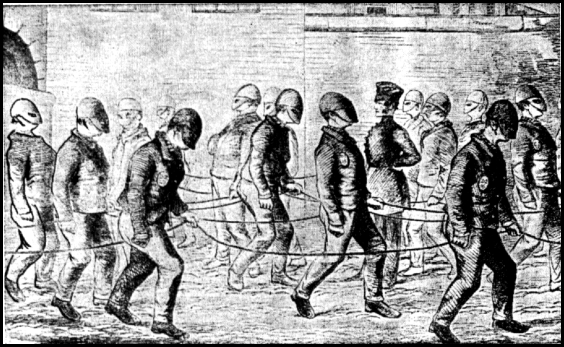 The prison was equipped with soundproof
materials and ventilation systems that would ensure absolute separation and
silence. Men spent twenty three hours each day in their cells; they only emerged
for exercise, school and chapel. Each cell had gas
lighting, and a toilet and water tap designed by the Prince of Wales, who took
keen interest in sanitation. Each door had an inspection peephole. Hundreds of rules and rigid daily routines reinforced the
inmate’s sense of powerlessness; they were calculated to train prisoners in the
virtues of order and discipline.
The eye that never slept..... a
cunningly contrived spy hole... No matter how you would place yourself in your
cell, standing, sitting, or lying down, that cursed eye seemed to follow you. –
One Who Has Endured It, Five Years Penal Servitude, 1877.
After our bath, one of the principal
warders read over the whole rules and regulations to us, strongly impressing on
us the necessity of observing every one of them, if we were to avoid punishment.
As it took him about three quarters of an hour to read them, by the time he had
got to the last rule I had forgotten all of the others. Bill Sykes,
Prison Life and Prison Poetry, 1881.
Rules to be invariably suspended over
the building. Pot-cover and pot under the table. Cell broom on the middle rail
of the table. Soap, comb, brush on the rail in front of the pot cover. Drinking
mugs, one each corner of the table, books behind the salt box. Slate against the
wall, behind books. – Pentonville Prison Rules and Regulations,
1842.
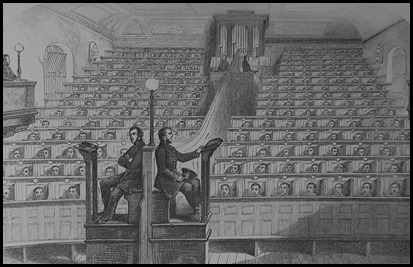 The chapel demonstrated the full flowering
of the principles of separation and discipline. Each man entered wearing his
mask (as at exercise), and moved into a coffin-like cubicle of the warder’s
instruction. Once inside, with the cubicle door locked behind him, he was
allowed to remove his mask. He could see no-one but the chaplain in the pulpit
and two guards. Even so, men found a way to subvert this isolation.
We will suppose for a moment that the
opening hymn is ‘Nearer My God to Thee’. An intending conversationalist sings
the first word of each line lustily, and then breaks into a lower tone as he
asks or answers questions – Frederick Brocklehurst, I was in prison,
1898.
A sample: (Loud) ‘Nearer’
(Soft) ‘How are you Jack’. (Loud) ‘Nearer’ (Soft)
‘All right’. (Loud) ‘My God’ (Soft) ‘When are you going out?’
(Loud) ‘To thee’ (Soft) ‘Monday week’.
A few months in the solitary cell
renders a prisoner strangely impressible. The chaplain can make the brawny navvy
cry like a child; he can work on his feelings in almost any way he pleases.....
Reverend John Clay, The Prison Chaplain,
1867.
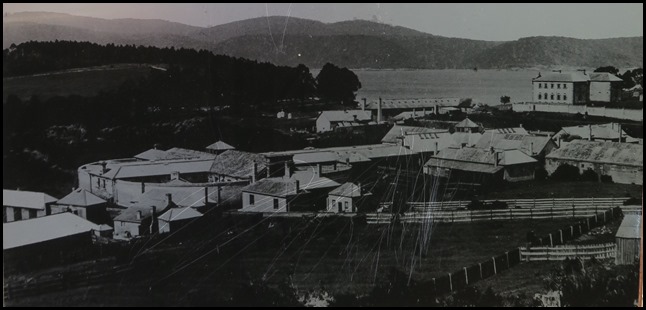 The Separate Prison
circa 1890’s. The officer in charge resided in a cottage located to the
rear of the chapel, this along with much of the prison was destroyed in the 1895
bushfires.
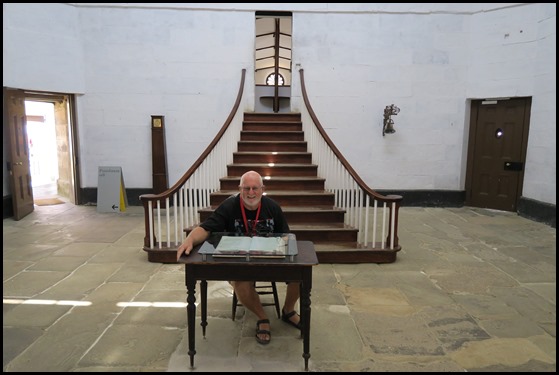 Through the main door, Bear adopted the
position of filling in the register and reading out
the many rules. The chapel is up the steps behind him. The back left door was
the way out to the exercise yards. To Bear’s left and right the corridors with
cells each side. We began to his left.
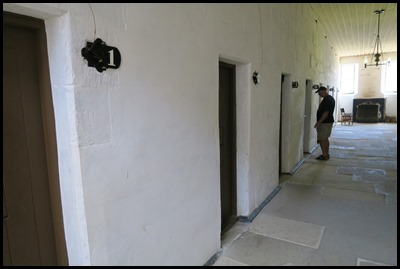 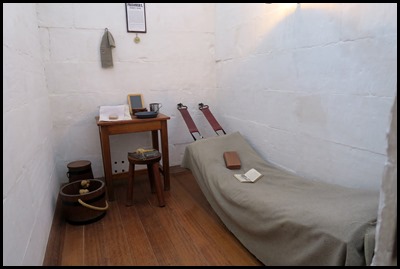 The corridor.
One of the cells. I thought looked rather comfortable
for such a grim place.
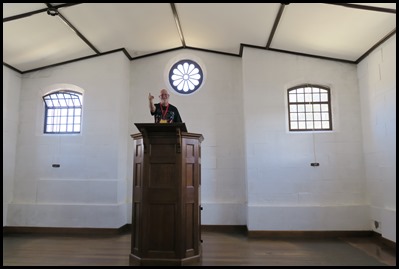 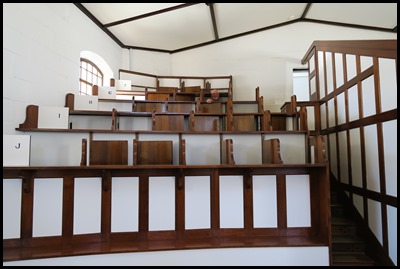 Back the way we came and up the steps to
the chapel. An austere looking room. The convicts
were isolated in a clever way, each was segregated in their
own stall.
 Once in their
place, the door closed.
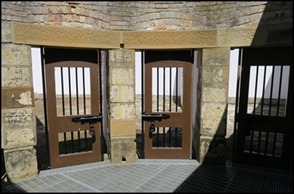 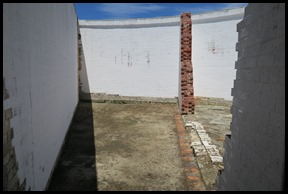 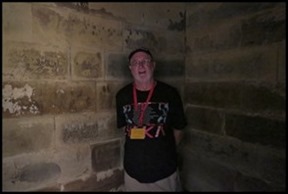 Outside locked
gates to the exercise yards, again segregated.
Bear tries one of the really isolated
cells.
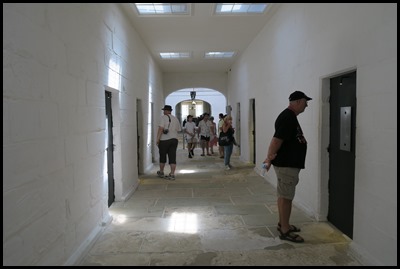 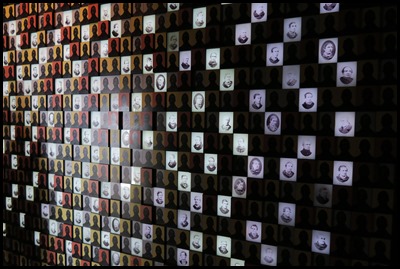 At the far end of the Separate Prison was
similar to the other end, a long corridor with calls each
side. One of the cells had as many pictures of the
convicts as is known about, many have no such record. Through peepholes
we read of some of the prisoners. We read about William Carter – a
twenty-seven-year-old Essex farm labourer. William left behind a wife and child
when he was transported for twelve years in 1843 for burglary. In 1867 he was
sentenced to death for bestiality. The Judge commented that it was “a pity that
a man who had borne such a good character for a long time should so far forget
himself as to commit such a crime”. William committed suicide in his cell a
month later, the only suicide in the Separate Prison. The inquest on the death
of William ..........being temporarily of insane mind, did in a cell in the
Separate Prison, with a leather strap, one end thereof he put about his neck,
and the other end fastened to an eyebolt by which his hammock was suspended, so
that he voluntarily suffocated....
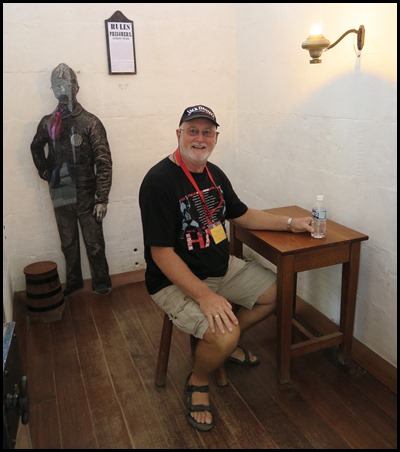 Nowadays, Bear
would be covered in tattoos and sporting hefty biceps............
The Legacy of the
Separate Prison: Today, prisons using many of the same ideas as this
Separate Prison are called Supermax facilities. One of the first was Katingal
(1975-1979), built inside Sydney’s Long Bay Correctional Centre. It was closed
down after two years over human rights concerns. But in 2001 Australia opened
another Supermax facility in the Goulburn Correctional Centre. Each prisoner has
his own cell and is generally allowed out for only one hour a day. He receives
his meals through a hatch in the door of his cell. If he is allowed exercise, it
is alone in a small, enclosed area. He is under constant
surveillance.
A psychiatrist who interviewed Supermax inmates said that most
of ‘their inability to concentrate, heightened anxiety, intermittent
disorientation and confusion, their experience of unreality, and their tendency
to strike out at the nearest person when they reach their “breaking point”’. We
read one chap in Katingal didn’t see the sun for two years and eight
months..............
These prisons are the inheritors of Port Arthur’s experiment
in breaking and remaking the minds of men.
ALL IN ALL PRISON CONDITIONS,
OTHER THAN FLOGGING............
RATHER STRANGE AND OUT OF
PLACE |
